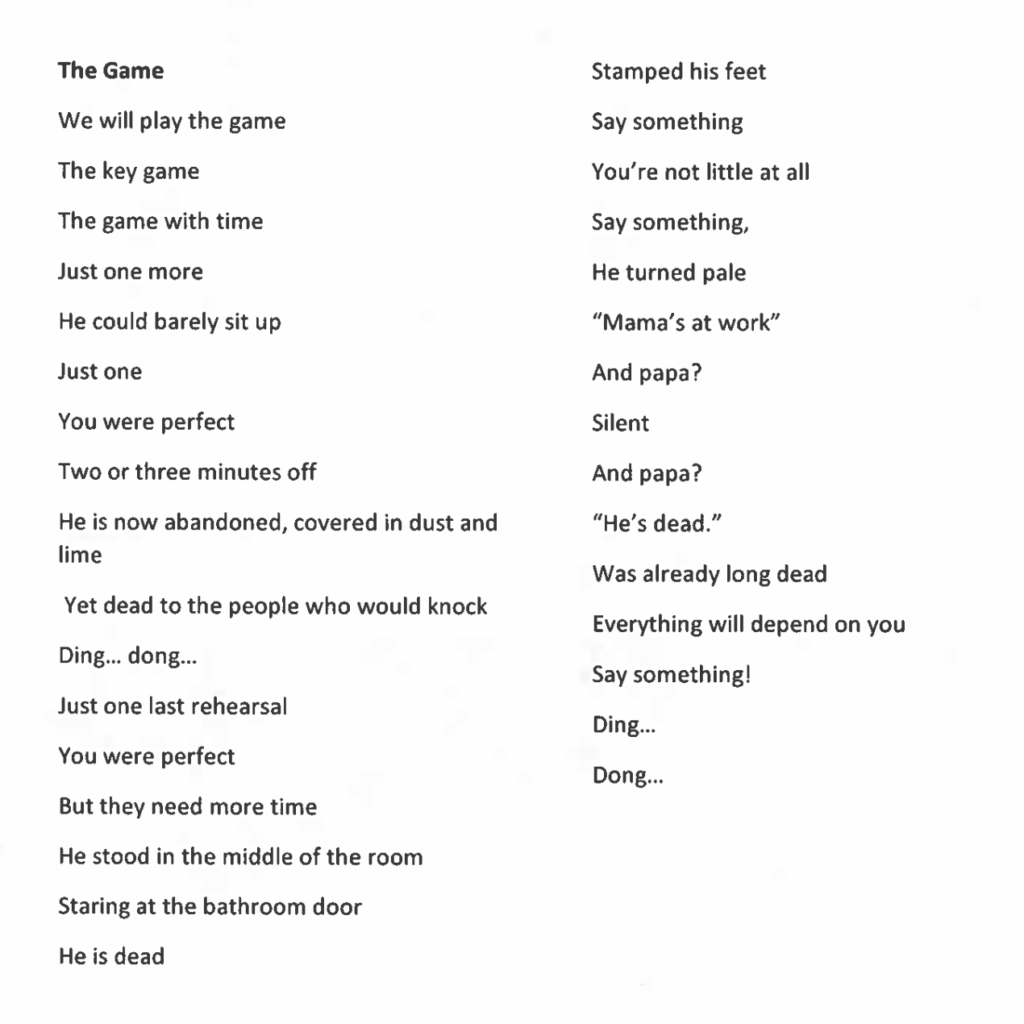Grand Prize Winner

3D Art-Middle School
Warsaw Uprising by Tyler Harpine
Springdale Middle School
“I used recycled boxes and paper to make my artwork. I wanted to make my project out of items I had around the house, like many had to during the war. The model shows the resistance of the Jewish Z.O.B. and the Polish people against the Germans. They demonstrated resilience when face against all odds. My project illustrates that you should never give up, even when discriminated against. I used images of the sewers and bombed buildings, to show the ingenuity of the people to move across the city without being spotted.”
Category Winners
Essay
Antisemitism: Then and Now by Stuart M Adams
Avonworth
Antisemitism is frequently associated with one time in history: the 1930s and 40s, as well as one specific
event: the Holocaust. While indeed the Holocaust and the Nazi regime in Germany were the peaks of modern
antisemitism, they are not the beginning of the movement nor the conclusion. Rather, the Jewish people have
been long the target of hate groups as well as persecution and even genocide. Antisemitism has changed in some
ways but has remained mostly the same. In order to break the cycle of Jewish hate, it is important to teach the Holocaust in schools properly and study it as students.
While the circumstances themselves have changed throughout history, the root of antisemitism has
barely changed, if at all. Since the days of ancient Egypt, the Jews have been the target of persecution. For
many years the myth that the Jews were behind the crucifixion of Christ has been spread and widely believed.
Only during the Second Vatican Council in the 1960s was the claim finally repudiated by the Catholic Church.
Jews were frequently blamed for the Bubonic plague during the Middle Ages due to their perceived immunity
from it. In reality, it was due to their more hygienic practices compared to the larger population of Europe. The
common thread throughout all of these examples is that the Jews are seen first as the other, as a collective elite
that makes decisions out of their own greed and just a purely evil nature. Another commonality is that it is all
blatantly false. None of these claims hold up under any scrutiny. Even today, when information is more
accessible than ever, antisemitic beliefs and conspiracy theories have been on the rise. Why is this? It comes
back to the root of antisemitism. The reason why these myths persist to this day, alongside new ones.
In his increasingly relevant article “Skin in the Game: How Antisemetism Animates White Nationalism”, Eric Ward describes how his own personal experience relates to anti semitism in the white nationlist sphere. White nationalists advocate for, among many things, the creation of a white ethno-state. If that sounds familiar, it is because that was also a primary objective of the Nazis. This is not the end of the comparisons. White nationalists believe that Jews are an inside threat, by assimilating they have infested our society and must be discriminated against in turn. It is also implicit that the Jews are a separate race unto themselves. These theories are directly inspired by Nazi ideology, which itself is inspired by centuries of.antisemitism. Why is that? Well, the core of antisemitism has not changed. The idea that the Jews are the “absolute other”, as Ward puts it, persists. How can these foundations, which have been present for centuries within society, be finally broken? In order to do so, we must utilize education and understanding of the best case study of these concepts: the Holocaust.
In 1943, a young Sophie Schull was executed by the Nazi regime. Her role in resistance against them
came in the form of pamphlets distributed amongst students at college campuses. Both Sophie and her society,
the White Rose, were eventually informed on by university staff. When the Gestapo confronted them, Sophie
along with many other members of the society were sentenced and executed. Sophie’s story is one of countless
people who gave their life in order to resist the Nazis. While her sacrifice was not in vain then, today we must
do even more to honor her. By teaching the Holocaust and educating students on the history of antisemitism, we
can spread information for good just like Sophie did 80 years ago. In addition, it also combats the spread of
these ideas so that they eventually cease to exist. While proper education will not eliminate hate all at once,
eventually antisemitism will die out after having no more uneducated people to prey on.
To summarize, the roots of antisemitism have changed very little since the dawn of the movement, to the
Holocaust, and even today. The best way to counter the movement is to better educate students on the true
nature of the Holocaust as well as the veracity of claims made by antisemites and white nationalists alike. While
this essay focuses on antisemitism, the ideas presented here can be applied to all kinds of hateful movements.
With a combined and coordinated effort through education, we as a society will be one step closer to the
equitable world we will all hopefully inhabit.
2D Art, High School
The Cellist by Sophia Rau
Shaler Area

“This work demonstrates the strength, perseverance, resistance, and resilience of Frieda Belinfante. Frieda is a talented cellist, conductor, and member of a Dutch lesbian resistance group during World War II. In this work, a rainbow pours from the cello, despite all the darkness surrounding it. The rainbow, often a symbol for the LGBTQ+ community, is used in this artwork to show how Frieda paved the way for the future generations. She broke boundaries and stereotypes. Frieda continued to fight back against the Nazi regime by living a successful life and sharing her musical talents in America after the war ended.”
2D Art, Middle School
The Courage of August Landmesser by Evelyn Bertiaux
Quaker Valley

“This is a portrait of August Landmesser who stood for what he believed in, despite the horrific punishment he knew he would suffer. This act of courage connects to many; it shows bravery despite troubles and hardship. August Landmesser rose to the challenging decision to not play along. When I was painting this I thought carefully about how I could illustrate the courage and light this image presents, I decided to flick paint around him to represent his bravery radiating off him. years later this small act makes ripples, showing the power of one action, one right step.”
3D Art, High School
Mirror by Bella Burrell
Springdale

“Mirror depicts the two weeks when Eva Mozes Kor and Mirriam Mozes Zieglar, survivors of the twin experiments, were separated. The clock strikes two in the “hospital.” Mirriam is threatened with supervision and lethal injection. Syringes litter the floor, one stuck in Eva’s arm. She reaches out, her survival dictating her sister’s, eyes constantly watching. Eva is known for her “power to forgive.” Depicting these events has allowed me to better understand her story, and why it is so powerful for her to forgive. Controlling your own forgiveness is something many people can use to reflect on their own trauma.”
Poetry, High School
Enough? by Piper Bozick
Mt. Lebanon

“Sir Nicholas Winton’s immense fortitude as he rescued children through the Kindertransport inspired the poem, “Enough?” Winton’s work was known at the time, but after the Holocaust he humbly never shared his story because he found it insignificant in comparison to all the lives lost. By starting a safety network for children in German-occupied Czechoslovakia, he was able to resist the Nazi party and provide shelter for nearly 700 children. The resilience he showed during this time is reflected in the lives of the children he saved. The two-voice structure highlights Winton’s struggle with accepting that his work was enough.”

Poetry, Middle School
The Game by Abby Mihalacki
Ryan Gloyer MS

“I wrote this found poem based on a story called ‘The Key Game.’ In this story, it shows how a little 3-year-old boy must hide his Jewish father from the Nazis. I took words directly from the story to create this poem, making it a found poem. I wanted to show the resilience that had to be used in the everyday lives of people in hiding during the time of the holocaust. I wanted to show how tough it must have been on all of the people who had to go through this, let alone a 3-year-old boy that has to resist against the Nazis or else his father could die. I want people to realize and feel how these people felt because I think empathy can be the most important thing in times of need.”
